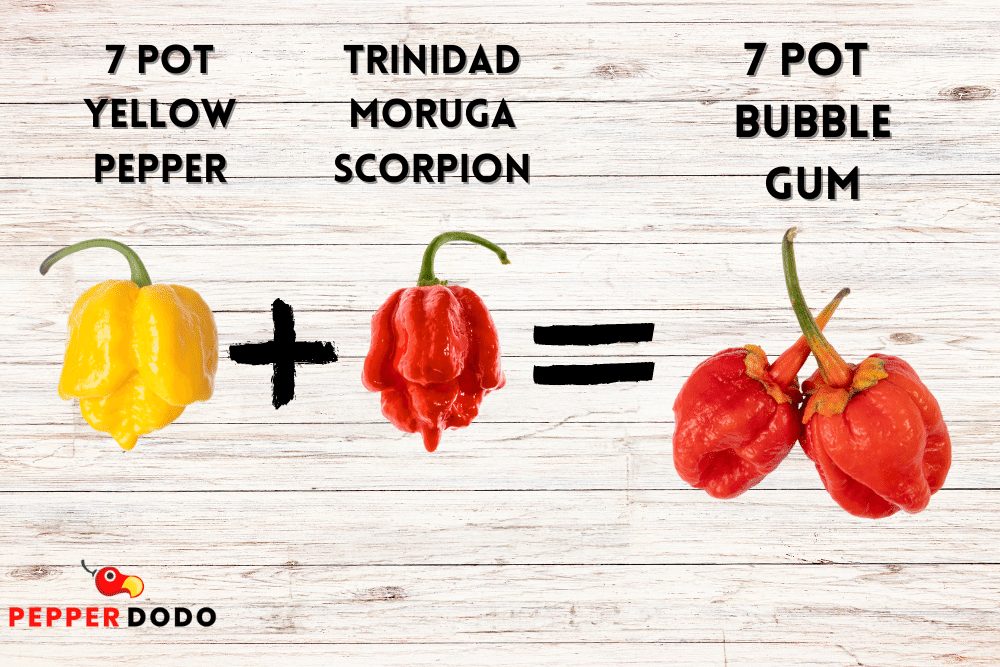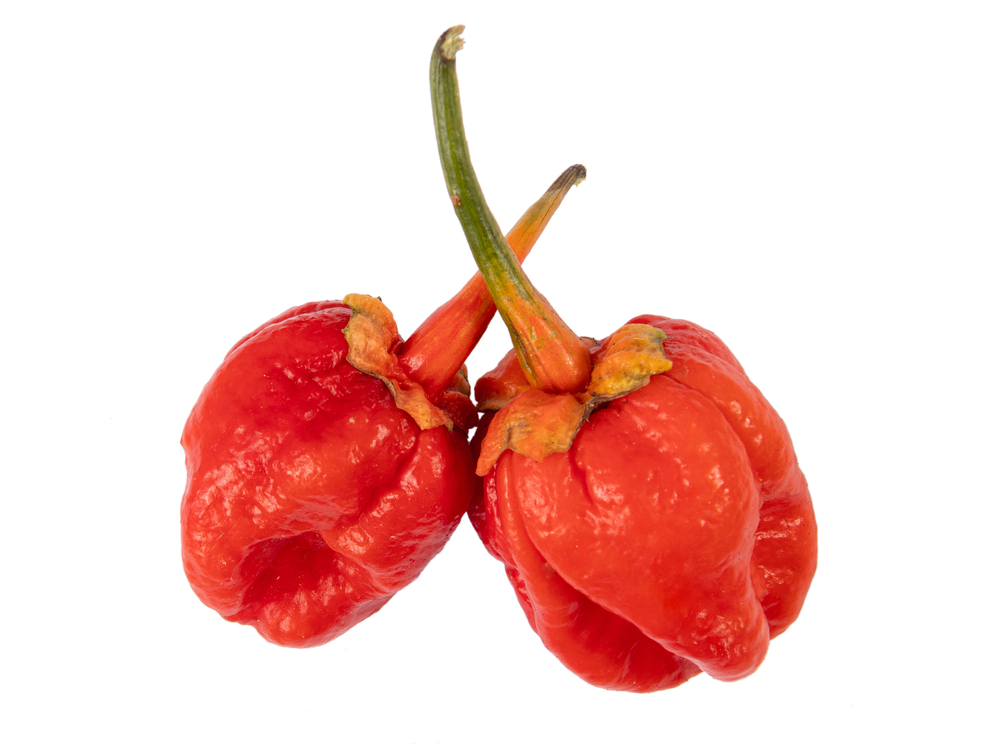The 7 pot bubblegum pepper is a hybrid of the 7 pot yellow and Trinidad Moruga scorpion pepper. It's a superhot pepper that can measure up to 1 million SHUs on the Scoville heat scale.
What Is A 7 pot bubblegum Pepper?
The 7 pot bubblegum pepper, also known as the ‘bleeding bubblegum’ or BBG7 pepper, was developed by Jon Harper in the United Kingdom. It is a cross between the hot 7 pot Yellow and Trinidad Moruga scorpion peppers.
BBG7 peppers are called 7 pot because one pod can be used in seven pots of soup and still provide a mouth-searing amount of heat. These peppers belong to the capsicum chinense family.
Taste
According to some bleeding bubblegum growers, this pepper’s flavor is comparable to bubblegum. The flavor is fruity and fruity—if you can get past the insane heat.
Appearance
BBG7 are known for their shape and large calyx (the top part of the stem that connects the stem to the pepper fruit) that resembles a wad of chewed bubblegum. They have a bulbous shape with wrinkles.
When young, the peppers are green and turn bubblegum red when ripe. The calyx and the stem also change to red upon maturity. It’s rare for the pepper color to ‘bleed’ into the calyx and stem like this; hence the name bleeding bubblegum. They can grow up to two inches long and one inch wide.

7 pot bubblegum Variants
- bubblegum white: A rare pepper created by crossing the 7 pot bubblegum and white ghost pepper.
- Orange bubblegum: A cross of the orange habanero, yellow 7 pot, and Trinidad Moruga scorpion.
- Chocolate bubblegum: The brown variant of BBG7 pepper. It is hotter than the yellow and red variants.
- Peachgum Tiger: A hybrid of the 7 pot bubblegum and pink tiger pepper. The peppers turn creamy peach from purple upon maturity.
How Hot Are 7 pot bubblegum Peppers?
At 850,000 to 1,000,000 SHUs, 7 pot bubblegum peppers are among the hottest peppers in the world. The intense heat is inherited from the Trinidad Moruga scorpion chili pepper, which boasts a Scoville rating of 2,009,000 SHUs.
The 7 pot bubblegum heat is similar to a ghost pepper (bhut jolokia), which measures between 855,000 and 1,041,427 SHUs. Jalapeno peppers cannot match the 7 pot bubblegum’s heat at only 2,500-8,000 SHUs.
What’s The Difference Between A bubblegum Pepper And Other 7 pot Peppers?
The Scoville heat units set the bubblegum peppers apart from other 7 pot Peppers. Here is how the 7 pot bubblegum compares to other 7 pot peppers:
- 7 pot bubblegum – 850,000-1,000,000 SHUs
- 7 pot douglah – 923,889-1,853,986 SHUs
- 7 pot brain strain – 1,000,000-1,350,000 SHUs
- 7 pot primo – 1,000,000-1,500,000 SHUs
How To Use 7 pot bubblegum Peppers
7 pot bubblegum peppers are a great addition to any dish that needs extreme heat. It can be used in soups, stews, or sauces that call for any superhot peppers with similar heat levels.
If you want to reduce the pepper’s heat, use it whole and remove it from the dish once the meal is ready. Like other hot peppers, removing the seeds and veins will also reduce the heat (slightly). Always start with a tiny amount and tread carefully when handling these peppers!
Recipes dedicated to 7 pot bubblegum peppers are hard to find. But you can modify any recipe that calls for peppers in the ~1M SHUs range.
Fruit salsas and hot sauces are well-suited to 7 pot bubblegum peppers because of the fruity, sweet flavors of the pepper. Most of these recipes call for habanero or scotch bonnet peppers though, which can be up to 10 times milder than 7 pot peppers. So you’ll want to significantly reduce the amount of 7 pot pepper you use in the same recipe.
Where To Buy bubblegum Peppers
Bubblegum peppers are unstable, so they are not as common as other 7 pot peppers. When a hybrid (developed) pepper is unstable, it means it hasn’t been grown for enough generations to produce fruit with consistent taste, appearance, and heat levels.
You can get bubblegum pepper seeds from online stores such as Amazon if you want to grow them. Fresh supplies are hard to find, but you can check the farmer’s markets or chili farms near you.
Substitutes For 7 pot bubblegum Peppers
If you can’t find 7 pot bubblegum peppers in your local market, you can use a variety of substitutes to get the same heat and flavor.
The Trinidad Scorpion pepper is a good match in heat and flavor, and it’s becoming more widely available in specialty markets. With a Scoville rating of up to 2,000,000 SHUs, this pepper is one of the hottest on the planet.
Another great substitute is the ghost pepper. This variety has a similar heat level as 7 pot bubblegum peppers and is easy to find in most grocery stores.
Can You Grow 7 pot bubblegum Peppers?
Yes, you can grow your 7 pot bubblegum peppers, but you won’t get consistent results. Like other new hybrid varieties, the breeding process is in progress, and the plants are unstable.
You may get varying heat levels from your plants, but this should not be a barrier to growing them.
If you want to grow 7 pot bubblegum peppers, start with seeds from a reputable supplier and plant them indoors. Planting them indoors will ensure the soil temperature is warm enough to promote germination.
Keep the soil moist and ensure the containers have good air circulation. Once some leaves appear, you can transplant them into larger containers or your garden. The plants take 90 to 100 days to reach maturity.
Because of the heat levels, you must be careful when handling 7 pot bubblegum peppers. The capsaicin of the peppers can cause burns on your skin, so wear gloves and protective eyewear when handling them.
Wash your hands thoroughly after handling the peppers, and avoid touching your eyes or other sensitive areas of your skin. If you get pepper juice on your skin, wash it off immediately with soap and water.

